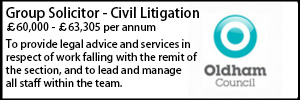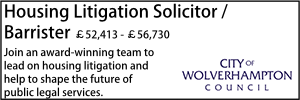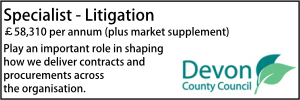Sex entertainment venues and nil cap policies: the Edinburgh ruling
- Details
Is the Edinburgh SEV Opinion really a victory for the strip club industry, asks Josef Cannon.
Some of the coverage of a recent ruling by the Court of Session in Scotland strongly implies a major victory for the strip industry in Scotland, and a blow for those advocating for a ‘nil cap’ on Sex Entertainment Venues in Scotland. Properly understood, the ruling appears nothing of the sort, and in fact may turn out to be the opposite.
In Scotland, legislation giving local authorities the powers to regulate strip clubs – including limiting how many should be licensed, if any - has only recently been introduced, by the Air Weapons and Licensing (Scotland) Act 2015. A similar regulatory scheme was introduced over a decade earlier in England and Wales – providing the familiar framework set out in Schedule 3 to the Local Government (Miscellaneous Provisions) Act 1982. The 2015 Act enables Scottish local authorities to adopt the (modified) provisions of Schedule 2 to the Civic Government (Scotland) Act 1982, originally drafted to regulate sex shops. In particular, the new regime – if adopted – requires a local authority to consider and determine “the appropriate number of Sexual Entertainment Venues” to be licensed in its area.
Edinburgh City Council, with 4 existing strip clubs in its area (dubbed ‘the pubic triangle’), resolved to adopt the regime, and to specify that the “appropriate number” of Sex Entertainment Venues (SEVs) in its area would be zero, with effect from 1st April 2023. Unsurprisingly, a legal challenge to this approach was launched by the operators of three of those venues (together with an employee of one of them). An additional party joined later - the United Sex Workers Union (which represents, amongst others, some of those that perform in SEVs). In early 2023 a Court of Session Judge gave his Opinion (or ruling).
The Judge ruled that Edinburgh City Council’s resolution was unlawful and should be reduced (or quashed). In short, he found that the Committee making the resolution had been materially misled as to the effect of what they were intending to do, in that the Report recommending the adoption of the powers had wrongly described the new powers as merely setting up a rebuttable presumption that renewals would be refused. In other words, rather than stating licenses must be refused under a nil cap, the committee were advised only that they ‘may’ refuse to license. However, on a proper analysis, a nil cap under the new regime would give no discretion at all, making it mandatory to refuse all SEV applications under it.
In Scotland (unlike in England and Wales), when a local authority sets a limit on strip club numbers (i.e. determines what is the “appropriate number”), this acts as an automatic reason for refusal should the number be exceeded by an application. This applies equally to renewal of an existing licence or when considering licensing a new premises. In short, the local authority must stick to the limit it decides upon. This means, in reality, that where a ‘nil cap’ is chosen, any existing SEVs applying to renew their licences would have to be refused: no discretion would arise. In England and Wales, this ground of refusal remains discretionary: a local authority in England and Wales could decide to renew an existing licence even if to do so would mean the ‘cap’ being exceeded.
The language of paragraph 9 (4) of Schedule 2 to the 2015 Act contains no such wriggle room for Scottish authorities: “…the local authority shall refuse an application for the grant or renewal of a licence” if the number of SEVs in the locality is equal to or exceeds the ‘appropriate number’ (emphasis added). The language is mandatory, not discretionary.
In the Edinburgh case, the misunderstanding (or misdescription) of the effect of a nil cap as ‘discretionary’ was sufficient for the Judge to rule that the decision to adopt the regime, and specify the ‘nil cap’, could not stand. To that extent, the case represents a victory for those wishing to see continued operation of SEVs in Edinburgh. However, there is much in the decision to draw on for those considering imposing a ‘nil cap’ under the new legislation (or those supporting such a move).
Before turning to those aspects, it might be said that (public law principles aside) there is little substantive difference between a situation in which a local authority determines that the appropriate number of SEVs in its area is nil, and has discretionary power to refuse applications which would mean that limit being exceeded, and the situation in Edinburgh, where such refusal would be mandatory. It is hard to see how, having determined the appropriate number to be nil, there would be much scope for making an exception to that, and renewing licences notwithstanding the cap – but in theory it would remain a potential outcome on the particular circumstances of an application. Indeed, in the Edinburgh case, the report contained a wealth of information addressing the consequences of reducing the number of SEVs in the city to nil, and it was clear that such an outcome was in the mind of those deciding to adopt the regime. However, what the Report did not make clear was that such an outcome was the inevitable result of adopting the provisions, because of their mandatory language and effect.
In fact, the claim was brought on multiple grounds, going well beyond the narrow ‘public law’ ground on which the claim succeeded. Although not strictly necessary to do so given the central finding, the Judge did go on to make various findings as to the legality of adopting a ‘nil cap’ in general, which findings are likely to be highly persuasive in future cases. In summary:
- The Council, despite the presence of a number of existing SEVs in its area, was perfectly entitled to introduce a ‘nil cap’;
- A ‘nil cap’ in Scotland means a de facto ban – SEV licenses could not be renewed or issued and no discretion to do so would arise;
- The introduction of a scheme for regulating SEVs – and indeed, featuring a ‘nil’ cap with mandatory effect – was not in principle a breach of the existing operators’ Article 1, Protocol 1 rights (‘peaceful enjoyment of possessions’);
- It was not unlawful to have had regard to a particular definition of ‘violence against women and girls’ as contained in the Scottish Government publication “Equally Safe”;
- As to whether introducing a ‘nil cap’ was or might be indirectly discriminatory against those who might work in SEVs, and if so, might nonetheless be justified, the judge declined to rule on this aspect of the case because it had not been fully argued in the submissions before the Court;
- There had been no breach of the PSED by resolving to introduce the nil cap: the Council had had due regard to the matters contained within s.149(1) of the Equalities Act 2010; and
- The challenge pursuant to ECHR Article 8 (‘right to respect for private and family life’) was dismissed: the union (who advanced this line of argument) was not a ‘victim’.
It is notable that some coverage of this decision in the legal and other press has characterised it as a defeat for those seeking tighter regulation of SEVs, or even seeking to do away with them entirely. In reality, it seems to point the other way. A defeat, for now, on the attempt to introduce a nil cap in Edinburgh, but a comprehensive indication that adopting a nil cap under the new regime, if done properly, would be likely to be lawful, even where existing SEVs were operating.
It remains to be seen whether the City of Edinburgh wish to return to the question of the nil cap, knowing (as they do now) that it would likely bring to an end the operation of the four SEVs in its area, probably for good, and result in a situation in which the “appropriate number” of SEVs in Edinburgh was matched by the actual number operating.
Josef Cannon is a barrister at Cornerstone Barristers.
18-03-2026 1:00 pm
01-07-2026 11:00 am






















